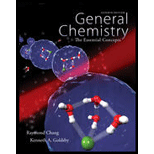
Concept explainers
(a)
Interpretation:
Stability of the compounds
Concept Introduction:
The energy released when gaseous state ions of unlike charges that are infinitely farther apart combine to form a stable ionic solid is called Lattice energy. Conversely, the energy required to break the electrostatic force of attraction between the ions of unlike charges in the ionic solid and revert them to gaseous state is also termed as Lattice energy of an ionic solid.
Greater the lattice energy of a compound greater will be its stability.
(b)
Interpretation:
Stability of the compounds
Concept Introduction:
The energy released when gaseous state ions of unlike charges that are infinitely farther apart combine to form a stable ionic solid is called Lattice energy. Conversely, the energy required to break the electrostatic force of attraction between the ions of unlike charges in the ionic solid and revert them to gaseous state is also termed as Lattice energy of an ionic solid.
Greater the lattice energy of a compound greater will be its stability.
(c)
Interpretation:
Stability of the compounds
Concept Introduction:
The energy released when gaseous state ions of unlike charges that are infinitely farther apart combine to form a stable ionic solid is called Lattice energy. Conversely, the energy required to break the electrostatic force of attraction between the ions of unlike charges in the ionic solid and revert them to gaseous state is also termed as Lattice energy of an ionic solid.
Greater the lattice energy of a compound greater will be its stability.
Want to see the full answer?
Check out a sample textbook solution
Chapter 9 Solutions
General Chemistry
 ChemistryChemistryISBN:9781305957404Author:Steven S. Zumdahl, Susan A. Zumdahl, Donald J. DeCostePublisher:Cengage Learning
ChemistryChemistryISBN:9781305957404Author:Steven S. Zumdahl, Susan A. Zumdahl, Donald J. DeCostePublisher:Cengage Learning ChemistryChemistryISBN:9781259911156Author:Raymond Chang Dr., Jason Overby ProfessorPublisher:McGraw-Hill Education
ChemistryChemistryISBN:9781259911156Author:Raymond Chang Dr., Jason Overby ProfessorPublisher:McGraw-Hill Education Principles of Instrumental AnalysisChemistryISBN:9781305577213Author:Douglas A. Skoog, F. James Holler, Stanley R. CrouchPublisher:Cengage Learning
Principles of Instrumental AnalysisChemistryISBN:9781305577213Author:Douglas A. Skoog, F. James Holler, Stanley R. CrouchPublisher:Cengage Learning Organic ChemistryChemistryISBN:9780078021558Author:Janice Gorzynski Smith Dr.Publisher:McGraw-Hill Education
Organic ChemistryChemistryISBN:9780078021558Author:Janice Gorzynski Smith Dr.Publisher:McGraw-Hill Education Chemistry: Principles and ReactionsChemistryISBN:9781305079373Author:William L. Masterton, Cecile N. HurleyPublisher:Cengage Learning
Chemistry: Principles and ReactionsChemistryISBN:9781305079373Author:William L. Masterton, Cecile N. HurleyPublisher:Cengage Learning Elementary Principles of Chemical Processes, Bind...ChemistryISBN:9781118431221Author:Richard M. Felder, Ronald W. Rousseau, Lisa G. BullardPublisher:WILEY
Elementary Principles of Chemical Processes, Bind...ChemistryISBN:9781118431221Author:Richard M. Felder, Ronald W. Rousseau, Lisa G. BullardPublisher:WILEY





